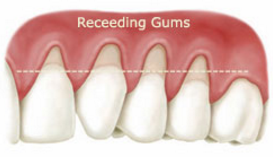Part 2: Gum Recession – Why Your Hygienist is Counting Out Loud

In Part I of this Blog post, we discussed measuring pocket depth. Recession and pocketing are not the same. When measuring pockets or “probing”, a periodontal probe is placed down in-between the tooth and gums to determine where the attachment of gum starts and helps determine the general periodontal or gum health. Recession is the loss of gum tissue from around the tooth thus exposing the root. With gum recession, this exposed root makes the tooth more susceptible to decay and can cause the teeth to be sensitive. Every two years, your hygienist will use a periodontal probe to measure the distance between the crown of the tooth and the edge of the gum. If the measurements keep increasing, we will address steps to arrest the situation.
The most obvious symptom of gum recession is the visible shift of gum tissue down the root of the tooth, causing the yellow dentin to be exposed. Normally, the roots of your teeth are covered by gum tissue.
Many factors may cause the gums to recede. These include:
- Badly positioned teeth
- Gum inflammation and periodontal disease
- Aggressive tooth brushing
Teeth with exposed roots can have several problems:
- Sensitivity to changes in temperature
- Food packing
- Increased risk of decay
- Unattractive appearance
- Long teeth – “long in the tooth”
- Spaces between teeth
Treatment for gum recession depends on the cause. If the gums become unattached from the tooth, it’s important to treat recession to maintain the tooth in the mouth.
- If the cause is from brushing too hard, your hygienist will show you a better way to brush to help prevent new damage.
- If the cause if periodontal disease, we may recommend periodontal therapy or “deep cleaning” to help gum tissue heal and hopefully reattach to the tooth.
- If the recession is advanced, we may recommend a gum graft. A thin piece of skin usually taken from the roof of the mouth is attached where the gum has receded to arrest further migration of the gum tissue.
So when you hear Ann or Claire counting out loud and have any questions, they will be happy to explain!



